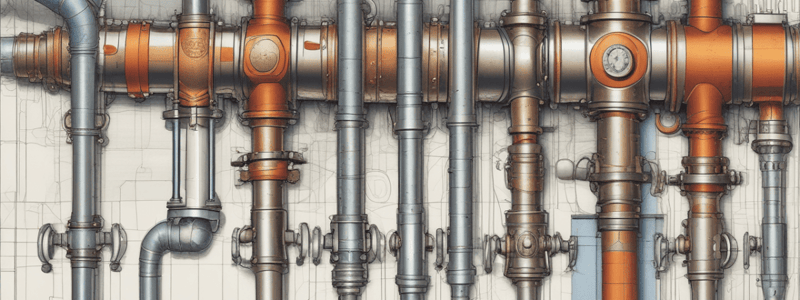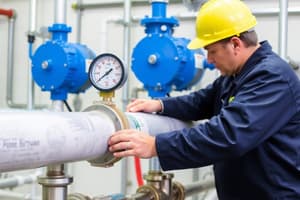Podcast
Questions and Answers
What is a crucial step to take before tightening tube fittings?
What is a crucial step to take before tightening tube fittings?
- Use a clamp to secure the tube to the airframe
- Pull the tubes into place with torque on the nut
- Apply a witness mark across the union
- Ensure the tube assembly is properly aligned (correct)
What is the purpose of having at least one bend in rigid tubing?
What is the purpose of having at least one bend in rigid tubing?
- To increase the tube's flexibility
- To reduce the tube's vibration
- To increase the tube's pressure capacity
- To remove stress from the fittings (correct)
What skill is required when fabricating hose assemblies?
What skill is required when fabricating hose assemblies?
- Ability to weld metal tubing
- Ability to design hose assemblies
- Ability to follow step-by-step instructions (correct)
- Ability to use power tools
Why is it essential to use clamps to secure tubes?
Why is it essential to use clamps to secure tubes?
What should be checked when inspecting clamps?
What should be checked when inspecting clamps?
What is the purpose of applying a witness mark across the union?
What is the purpose of applying a witness mark across the union?
What is the purpose of lubricating the fitting during the pre-setting process?
What is the purpose of lubricating the fitting during the pre-setting process?
What is the correct position of the pilot and cutting edge of the sleeve during the pre-setting process?
What is the correct position of the pilot and cutting edge of the sleeve during the pre-setting process?
How should the tube be positioned in the pre-setting tool seat?
How should the tube be positioned in the pre-setting tool seat?
What is the minimum internal tube diameter requirement?
What is the minimum internal tube diameter requirement?
What should be the condition of the sealing surface of the sleeve after pre-setting?
What should be the condition of the sealing surface of the sleeve after pre-setting?
What is the correct amount of embedment of the sleeve cutting lip into the tube's outside diameter?
What is the correct amount of embedment of the sleeve cutting lip into the tube's outside diameter?
What is the purpose of the swivel nut or flange?
What is the purpose of the swivel nut or flange?
Why is it important not to intermix nipples and sockets from different manufacturers?
Why is it important not to intermix nipples and sockets from different manufacturers?
What is the purpose of pressure testing fabricated hoses?
What is the purpose of pressure testing fabricated hoses?
What is the alternative to pressure testing a new purchased hose from an approved vendor?
What is the alternative to pressure testing a new purchased hose from an approved vendor?
What is the consequence of a hose assembly failing a pressure test?
What is the consequence of a hose assembly failing a pressure test?
How are flared or flareless fittings and nuts identified?
How are flared or flareless fittings and nuts identified?
What is the purpose of adding 5%–8% to the determined hose length?
What is the purpose of adding 5%–8% to the determined hose length?
What is the purpose of wrapping the hose with masking or plastic electrical tape?
What is the purpose of wrapping the hose with masking or plastic electrical tape?
How should the hose be cut to the required length?
How should the hose be cut to the required length?
What should be done to the hose after it is cut to the required length?
What should be done to the hose after it is cut to the required length?
What should be done to the hose when screwing it into the socket?
What should be done to the hose when screwing it into the socket?
What is the purpose of the nipple and nut in the hose assembly?
What is the purpose of the nipple and nut in the hose assembly?
What should be inspected for signs of deterioration in a hose?
What should be inspected for signs of deterioration in a hose?
What action should be taken if a hose is found to be kinked?
What action should be taken if a hose is found to be kinked?
Why is it important to inspect the braid of a hose?
Why is it important to inspect the braid of a hose?
What should be checked when inspecting end fittings?
What should be checked when inspecting end fittings?
What is a common indication of corrosion in a hose with carbon steel wire braid?
What is a common indication of corrosion in a hose with carbon steel wire braid?
What should be done if a hose is found to be twisted?
What should be done if a hose is found to be twisted?
Flashcards are hidden until you start studying
Study Notes
Flareless Fitting Installation
- Clamp the pre-setting tool or flareless fitting body in a vice
- Slide a nut and then a sleeve onto the tube, ensuring the pilot and cutting edge of the sleeve points towards the end of the tube
- Lubricate the fitting, insert the ram, and tap lightly with a hammer or mallet until the upset flare punch contacts the die blocks and the die blocks are set against the stop plate on the bottom
- Place the tube end firmly against the bottom of the pre-setting tool seat while slowly screwing the nut onto the tool threads with a wrench until the tube cannot be rotated with thumb and fingers
- Tighten the nut to the number of turns specified in the maintenance manual
- After pre-setting, unscrew the nut from the pre-setting tool or flareless fitting body; check the sleeve and tube
Sleeve Inspection
- The sleeve cutting lip should be embedded into the tube's outside diameter between 0.003 and 0.008 in.
- A lip of tube material will be raised under the sleeve pilot
- The sleeve should be bowed slightly
- It may rotate on the tube and have no lengthwise movement
- The sealing surface of the sleeve, which contacts the 24° angle of the fitting body seat, should be smooth, free from scores, and show no lengthwise or circular cracks
- The minimum internal tube diameter should not be less than the value shown in the table
Tube Securing to Airframe
- Use cushioned P clamps to secure the tube to the airframe
- Ensure the tube assembly is properly aligned before tightening the fittings
- Do not pull the tubes into place with torque on the nut
- Rigid tubing expands and contracts under pressure and is subject to vibration, so it should have at least one bend to remove stress
Hose Assemblies and Fittings
- Fabricating hose assemblies requires basic skills and hand tools
- Determine the necessary hose length from the table and diagram
- Add 5%–8% to allow for expansion or contraction from pressure application
- Wrap the circumference of the hose with masking or plastic electrical tape at the cut-off to prevent braid flare-out
- Measure the hose to the required length and cut off the required length, making sure it is square, using a cut-off machine
- Blow the hose clean with filtered shop air after cutting
- Remove the tape and the clamp socket in a vice
- Install the hose end fitting in a twisting, pushing motion until the hose bottoms on the socket shoulder
Hose End Fitting Installation
- Do not over-tighten a vice on thin-walled lightweight fittings
- Assemble the nipple and nut with a standard matching the inside diameter of the hose
- Nipples have three configurations for the hose-to-tube or component surface-sealing portion: flared, flareless, and flanged
- The socket fits over the outside diameter of the hose and secures one end of the nipple to the hose
- The swivel nut or flange secures the other end of the nipple to the mating connection in the fluid system
Pressure Test Stands
- All flexible hose manufactured in the shop must be hydraulic or pneumatic pressure tested prior to installation in the aircraft
- Fabricated hoses must be tested to 1.5 times system pressure
- A new purchased hose from an approved vendor can be operationally checked after installation in the aircraft by using system pressure in lieu of pressure testing
Pre-installation Procedures
- Check hose or hose assembly installations carefully to make sure identification bands and protective closures are present as required after proof pressure testing
- Ensure proper routing and clamping are mandatory
- Look for kinks or twists in the hose
- Observe the lay line, if possible
- A kinked hose or hose assembly must be replaced
- One that is twisted may be relieved by loosening clamps and swivel nuts, and then straightening the hose by hand
- Re-torque the swivel nuts and tighten the clamps
Studying That Suits You
Use AI to generate personalized quizzes and flashcards to suit your learning preferences.




